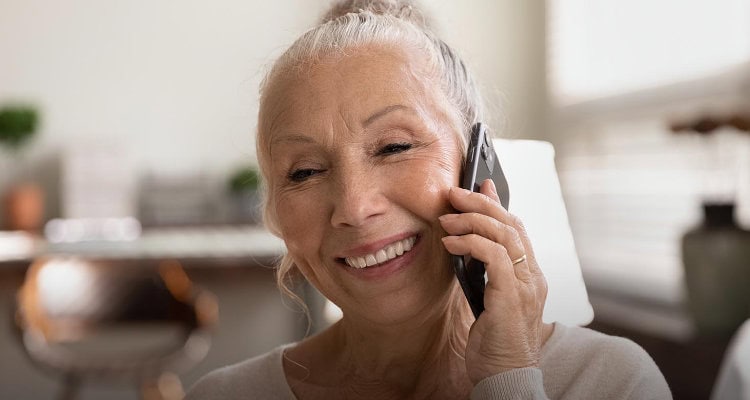Good customer service isn’t just important; it’s essential, yet a startling statistic from Later Living directory Lottie shows that an eye-opening 92% of initial enquiries in the Later Living community go unanswered for over a week.
This communication gap can significantly impact your sales rates, and is often the reason why a potential resident chooses one community over another.
This article examines the critical importance of swift follow-ups on enquiries and strategies for staying in regular contact with potential residents. Adopting these practices will keep your community at the forefront of people’s minds, boosting occupancy rates and reinforcing your reputation as a caring and responsive choice.
What Is Following Up?
A follow-up is more than just a check-in; it’s extending a warm, inviting hand, whether, over the phone, via email, or through other communication methods. When you follow up with a potential resident, you’re not just making contact but showing that you genuinely care and are eager to support them.
By maintaining contact, you foster a personal and supportive relationship. It’s about keeping the conversation alive and confidently guiding them towards making a decision that feels right for them. Think of each follow-up as a gentle step along the path that could lead them to choose your community as their new home.
Why Follow-Up Matters
Understanding the journey from initial enquiry to move-in is crucial in the later living sector. Research from CRM platforms like Aline highlights that it typically takes 252 days for a prospective resident to decide on moving into a retirement village and 92 days for a care home.
This extended timeline is due to the involvement of multiple decision-makers, often including family members such as sons and daughters who act as influencers in the decision process.
Given these timelines, it becomes evident why maintaining consistent and meaningful follow-up is critical. On average, it takes 22 – 28 touches from the initial enquiry to move-in for later living communities. This prolonged engagement requires a strategy that keeps potential residents interested and actively involves their family influencers throughout the process.
‘On average, it takes between 22 and 28 touches from enquiry to move-in for Later living communities, highlighting the importance of consistent follow-up’
To effectively manage this, regular updates, personalised communications, and targeted content addressing all parties’ concerns and interests are essential. Use every interaction to reinforce the value of your community and the care provided, ensuring that each touchpoint is an opportunity to build trust and confidence in your services further.
A follow-up does more than merely check in – it forges deep connections with potential residents, significantly increasing the likelihood that they will choose your community over others.
Consider the value of timely follow-up – it serves as comforting reassurance, addressing any lingering doubts or questions, and reinforcing a sense of security and attentive care. Alternatively, think about the missed opportunities when follow-up is neglected. When prospects contact your community, they often experience high emotions in relation to this big life change and expect high levels of service and support.
Imagine someone comparing different communities for themselves or a loved one. They receive a warm welcome everywhere, but only your community follows up, providing additional information and answering their queries. Which community do you think will leave a lasting impression? Which will they perceive as truly attentive to their needs?
Effective follow-up communications are essential. They ensure your community remains prominent in their minds and demonstrate to prospective residents that you are dedicated to supporting them throughout their decision-making process.
Follow-up helps build relationships, demonstrating a genuine interest, and showing a deep commitment to people’s experience and well-being.
‘Consistent follow-up increases engagement and satisfaction, helping potential residents feel more confident in their decisions’.
Common Challenges in Follow-Up Call Management
A survey by LeadConnect highlights a startling reality: 78% of customers choose the first responder to their enquiry. Simply put, the speed and warmth of our response can set the stage for a lasting relationship. Below are a few of the challenges a customer might face:
- Extended hold times. Imagine the frustration of waiting to hear a friendly voice, only to be greeted by an impersonal hold message. This can make potential residents feel unimportant from the outset.
- Calls going to voicemail. It’s like knocking on a door that never opens. When calls go directly to voicemail, it sends a message that we might not be ready to listen.
- Mis- directed calls. There’s nothing more disheartening than being passed around without ever reaching someone who can help. It can make families feel lost in a maze.
How to Follow Up Effectively
In our communities, we need to view each phone call not just as a query, but as an opportunity to begin building a relationship. By enhancing how you handle initial contacts, you not only improve the chances of welcoming new residents but also affirm your reputation as a compassionate, responsive choice.
Follow-up is an art that requires a balance between persistence and sensitivity. Here are some tips to make each interaction meaningful:
Be Timely: Quick and Consistent Follow-ups Matter
Responding promptly to enquiries demonstrates your commitment and significantly increases the likelihood of successfully engaging a potential client. Aim to reply within an hour of receiving an initial enquiry whenever possible. If that’s not feasible, ensure you respond no later than 24 hours from the first point of contact.
However, the initial response is just the beginning. Continued engagement is key to nurturing a trusting relationship. To ensure no one feels overlooked, schedule regular follow-ups every 3-4 weeks. This consistent communication strategy can be seamlessly managed with a Customer Relationship Management (CRM) system. Such tools are invaluable as they can remind you of these critical touchpoints, helping to build a rapport that feels both personal and caring.
Using a CRM not only helps in scheduling these interactions but also in personalising each communication. By keeping track of previous conversations, preferences, and specific needs, you can tailor your messages to resonate deeply, showing that you truly understand and value each individual’s unique situation. This approach fosters a sense of belonging and care and solidifies your reputation as a reliable and empathetic provider in the care sector.
Personalise your communications.
Use the prospective resident’s name, refer back to specific points discussed during their initial enquiry, and ensure your messages resonate on a personal level.
Respect preferences.
Families have different communication preferences. Some may prefer phone calls, while others prefer email or even text messages. Respecting these preferences demonstrates that you are attentive and adaptable.
Use email campaigns.
Regularly sending newsletters or emails is a fantastic way to keep potential residents engaged and informed. These communications can include invitations to upcoming events, updates about your community, and information about living options, providing ongoing value and keeping your community top of mind.
To further enhance the effectiveness of these email campaigns, consider including engaging and relevant content that helps nudge potential clients further down the funnel. For example, incorporate videos of customer testimonials to showcase the happiness and satisfaction of current residents. These real-life stories add a personal touch and can significantly influence decision-making by illustrating the positive experiences of those already living in the community.
Additionally, include useful articles on topics like downsizing, which provide practical advice and support for those considering making a move. These resources not only offer value but also position your community as a helpful and knowledgeable ally in their journey.
By combining informative updates with compelling content, your email campaigns can more effectively engage potential residents, guiding them smoothly through their decision process and closer to choosing your community as their new home.
Creative follow-up.
To make your follow-ups more effective and memorable, personalise your approach based on the individual interests of potential residents. During your initial interactions, note hobbies or preferences that are expressed. This information becomes invaluable when you want to connect on a more personal level.
For instance, if a potential resident mentions a fondness for dogs, consider sending them a card with a charming image related to their love of dogs on the front. Similarly, a small gardening book or a newsletter featuring gardening tips could be an excellent follow-up gift if someone expresses an interest in gardening.
These thoughtful gestures show that you listen and care enough to tailor your communication to their specific likes. This not only delights the recipient but also significantly enhances the feeling of community and personal attention they can expect to experience. Such creative follow-ups can greatly influence their decision-making process, making your community stand out as a genuinely considerate and engaging choice.
How Technology Can Help in Follow-Up
Technology can significantly enhance the efficiency of follow-up processes without losing the personal touch.
Using a CRM.
Using a CRM (Customer Relationship Management) system, you can automate reminders, keep track of preferences, manage communication logs, and send targeted emails and event invites seamlessly. This ensures no one is forgotten and every follow-up is personalised.
Text Messaging.
Expanding your follow-up strategy to include SMS messages can enhance responsiveness. SMS offers a direct and personal touch, allowing you to reach leads quickly and conveniently. This method is particularly effective because it ensures your message will likely be read soon after delivery. Most people check their messages frequently throughout the day, which means an SMS could provide immediate reassurance and a personal touch that emails or phone calls sometimes fail to achieve.
Handling Objections During Follow-Up
You may encounter various objections when following up with potential residents or their families. These objections are not just hurdles but opportunities to understand and address their concerns better.
Here’s how to handle objections effectively:
- Listen and Empathise: Always listen carefully to the concerns being raised. Empathy goes a long way in making the prospective resident feel heard and valued. Acknowledging their feelings and showing that you understand their point of view is important.
- Ask Questions: After listening, ask clarifying questions. This will help you understand the root of the objection and allow them to elaborate on their concerns.
Some examples might be:
- “I want to make sure I’m understanding you completely. Could you tell me a bit more about that?”
- “It sounds like you would like something specific. Please share more about that. I’d love to see if we can help.”
- “Thanks for sharing your thoughts. Could you paint me a clearer picture of what you’re expecting?”
- Provide Solutions: Once you fully understand the objection, offer a solution or alternative that addresses the concern. Tailor your response to show how your later living community can meet their needs or alleviate their worries.
- Follow-Up with Gratitude and Empathy: Thank them for sharing their concerns and express empathy. Let them know that their satisfaction is your priority and that you’re committed to finding the best solution for them.
- Use a Question-Based Framework: A question-based approach can help the prospect see the benefits of your community for themselves. By asking the right questions, you can lead them to conclude that moving forward with your community is the best decision.
- Be Prepared: Anticipate common objections and have responses ready. This preparation shows you’re knowledgeable and confident in your community’s value.
- Confirm Understanding: Before proceeding, make sure you and the potential resident are on the same page and that you’ve addressed their concerns to their satisfaction, for example, “Is there anything else I can help you with today?”
- Confirm Understanding and Offer Reassurance: Before proceeding in the decision-making process, it’s vital to ensure that both you and the potential resident are on the same page. Confirm that all their concerns have been addressed to their satisfaction by asking, for example, “Is there anything else I can help you with today?” This not only shows that you value their concerns but also helps clarify any outstanding issues.
To further strengthen their confidence, consider offering to send links to testimonials from current residents or videos that address common concerns.
By incorporating these strategies into your follow-up process, you can turn objections into constructive conversations that build trust and move you closer to securing a new resident for your community.
Final Thoughts
Think about your current follow-up strategy. Could it be more personalised? More timely? By implementing these strategic follow-up practices, your later living community can increase occupancy rates and build lasting relationships based on trust and empathy.
It’s not just about securing a place to live; it’s about creating a place to belong. With the support of a robust CRM system, you are equipped to deliver this promise consistently and compassionately, ensuring that every individual feels they are genuinely part of your community.
A Look Ahead
Join us next time as we examine why a marketing strategy is important, how it differs from a marketing plan – and why you need both.
Ready to enhance your community’s success? Let’s discuss how we can transform your sales and marketing efforts to increase your occupancy rating.




